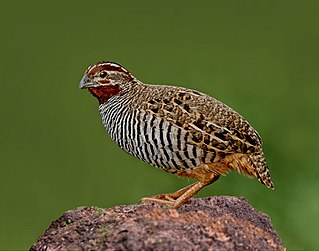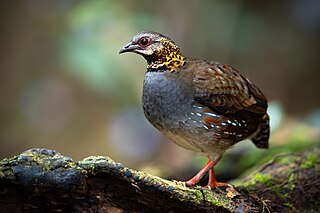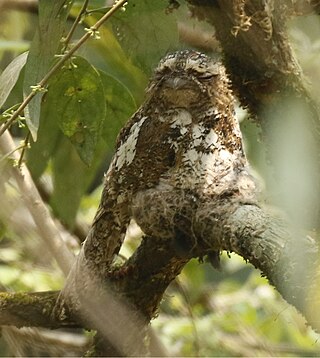
The grey partridge is a bird in the pheasant family Phasianidae of the order Galliformes, gallinaceous birds. The scientific name is the Latin for "partridge", and like the English name, is derived from Ancient Greek πέρδιξ "perdix".

The green peafowl or Indonesian peafowl is a peafowl species native to the tropical forests of Southeast Asia and Indochina. It is the national bird of Myanmar. Formerly common throughout Southeast Asia, only a few isolated populations survive in Cambodia and adjacent areas of Vietnam. It has been listed as endangered on the IUCN Red List since 2009, primarily due to widespread deforestation, agriculture and loss of suitable habitat, severely fragmenting populations and contributing to an overall decline in numbers. The green peafowl is in demand for private and home aviculture and threatened by the pet trade, feather collectors and hunters for meat and targeted.

The long-tailed broadbill is a species of bird that is found in the Himalayas, extending east through Northeastern India to Southeast Asia. It is the only bird in the genus Psarisomus. The long-tailed broadbill is about 25 cm (10 inches) in length and weighs between 50 and 60 grams. It can be identified by its shrill call.

Edwards's pheasant is a bird of the pheasant family Phasianidae and is endemic to the seasonal tropical forests of central Vietnam. It is named after the French ornithologist Alphonse Milne-Edwards and first described to science in 1896. The bird's length is 58–65 centimetres (23–26 in) and has red legs and facial skin. The male is mainly blue-black with a crest, and the female is a drab brown bird. The alarm call is a puk!-puk!-puk!.

The Caspian snowcock is a snowcock in the pheasant family Phasianidae of the order Galliformes, gallinaceous birds. Dari partridge or valley partridge [2] is the name of a species of the subfamily of partridges and pheasant family. Its origin is the north of Afghanistan, areas of the Hindu Kush mountains and a large area of Takhars slopes

The crested partridge also known as the crested wood partridge, roul-roul, red-crowned wood partridge, green wood quail or green wood partridge is a gamebird in the pheasant family Phasianidae of the order Galliformes, gallinaceous birds. It is the only member of the genus Rollulus.

The Daurian partridge, also known as steppe partridge, Asian grey partridge or bearded partridge, is a gamebird in the pheasant family Phasianidae of the order Galliformes. Its name derives from the Dauria region of Russia, which forms part of their distribution.

The jungle bush quail is a species of quail in the family Phasianidae. It is native to the Indian subcontinent, where it is found in peninsular India and Sri Lanka. It has also been reported from Nepal but has not been seen there since the 19th century, and an introduced population exists on the island of Réunion. A small species of quail 15–18 cm (5.9–7.1 in) long and weighing 57–82 g (2.0–2.9 oz), it shows significant sexual dimorphism. Males have brown upperparts with blackish and buff marking and whitish underparts with black barring. The face is mainly dark reddish-brown, with brown ear-coverts, a buffy-white moustachial stripe, and the supercilium turning whitish towards the back of the neck. Females have a similar pattern, but with pinkish-brown underparts, more uniform wings, and duller moustachial stripes.

The Crested argus is a species of large peafowl-like bird in the genus Rheinardia of the pheasant family.

The Japanese quail, also known as the coturnix quail, is a species of Old World quail found in East Asia. First considered a subspecies of the common quail, it is now considered as a separate species. The Japanese quail has played an active role in the lives of humanity since the 12th century, and continues to play major roles in industry and scientific research. Where it is found, the species is abundant across most of its range. Currently, there are a few true breeding mutations of the Japanese quail. The varieties currently found in the United States include Pharaoh, Italian, Manchurian, Tibetan, Rosetta, along with the following mutations: sex-linked brown, fee, roux, silver, andalusian, blue/blau, white winged pied, progressive pied, albino, calico, sparkly, as well as non-color mutations such as celadon.

The Arabian partridge is a species of bird in the family Phasianidae, native to the southern Arabian Peninsula. Two subspecies are recognised, A. m. melanocephala and A. m. guichardi. It sometimes hybridises with Philby's partridge and with the rock partridge.

The Hainan partridge is a species of bird in the family Phasianidae. It is endemic to Hainan Island, China. Its natural habitats are primary evergreen forests. It is threatened by habitat loss and has been assessed as a vulnerable species.

The bar-backed partridge, also known as the brown-breasted hill-partridge, is a species of partridge in the family Phasianidae. It is found in southwestern China and Southeast Asia.

The rufous-throated partridge is a species of bird in the family Phasianidae. It is found in montane forests in India and Southeast Asia. The International Union for Conservation of Nature (IUCN) has assessed it as a least-concern species.

The common hill partridge, necklaced hill partridge, or simply hill partridge is a species of bird in the pheasant family found in Asia.

The mountain bamboo partridge is a species of bird in the family Phasianidae. It is found in Bangladesh, Tibet, India, Laos, Myanmar, Thailand, and Vietnam.

Hodgson's frogmouth is a species of bird in the family Podargidae. It is found in Bangladesh, Bhutan, China, India, Laos, Myanmar, Thailand, and Vietnam. Its natural habitat is temperate forests.

The lesser racket-tailed drongo is a species of bird in the family Dicruridae. It is found in the Indian Subcontinent and Southeast Asia.

Medauroidea extradentata, commonly known as the Vietnamese or Annam walking stick, is a species of the family Phasmatidae. They originate in Vietnam and are found in tropical forests there. They eat a variety of foliage, though in captivity they commonly eat blackberry bramble, hawthorn, oak, red maple, and roses.

The Vietnamese crested argus is a large and spectacular peafowl-like species of bird in the pheasant family with dark-brown-spotted black and buff plumage, a heavy pink bill, brown irises and blue skin around the eyes. The head has two crests; the hind crest, which extends down the occiput, is erected when alarmed and during intentional behaviors including pair bonding and courtship displays. The male has a broad and greatly elongated tail of twelve feathers. The tail covert of the male is the longest of any bird and is believed to contain the longest feathers to occur in a wild bird; the Reeves's pheasant has tail feathers of similar length but which are considerably narrower. The tail coverts measure up to 1.73 m (5.7 ft) in length, giving the bird a total length of 1.9–2.39 m (6.2–7.8 ft).


















